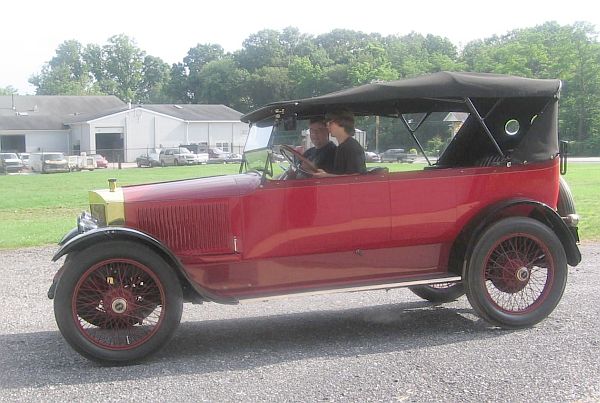
FAHP participates or plans steam car tours to provide a means for their student drivers to gain operating experience. FAHP members Richie and Sam Gregg have been learning the technical aspects of a Stanley and how to operate the car with FAHP member Bob Wilhelm using his 1918 Model 735.
Pictured is Sam Gregg behind the steering wheel with Bob Wilhelm as instructor as Sam prepares to take the Model 735 out for a driving lesson in early 2013.
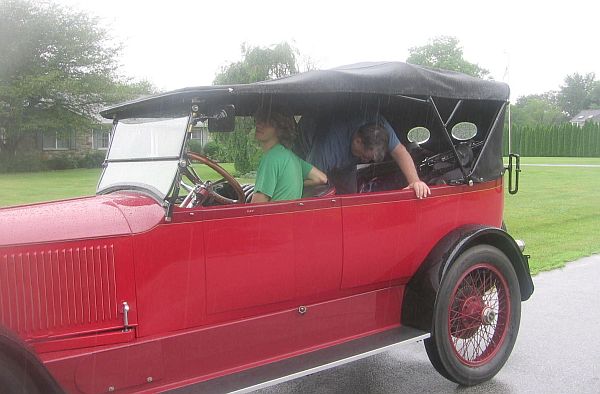
Approximately 20 miles into the trip the Model 735 suffered its first mechanical incident. A "pop" followed by constant "hiss-hiss" was heard. Finding a nearby development street to pull into the problem was quickly diagnosed ~ cylinder packing.
Bob Wilhelm moves tool bags and parts bins to the rear seat to gain access through to floorboards to the engine. The left cylinder's piston rod packing gland nut had backed off allowing the graphite packing to blow out. The problem was easily corrected but took about 45 minutes to accomplish.
In a more steady rain Richie worked from under the car while Bob worked from the top to install new rounds of graphite packing. A curious neighbor was happy to supply the team a couple of coat hangers that could be fashioned into a "keeper" to prevent the packing nut from backing off during the rest of the trip.
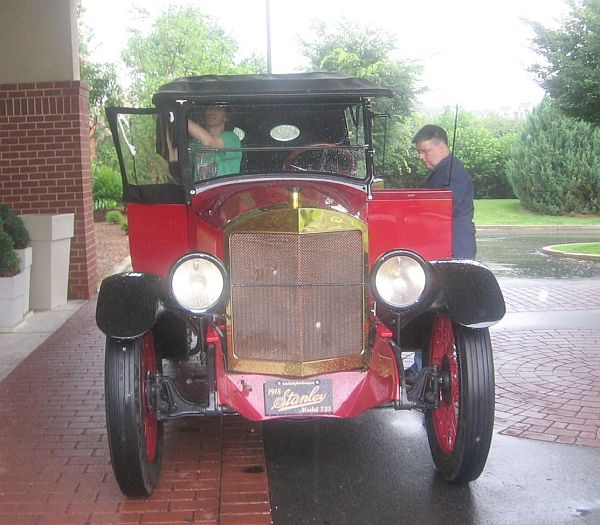
Condensing cars recycle the water and thus are capable of traveling more miles before needing a fill-up. The four condensing cars were easily able to make the complete trip from Auburn Heights to Chestertown, Maryland on a single 25-gallon tank of water. The non-condensing cars would require a single water stop at the half way point.
As the tour headed south over the Chesapeake Canal Bridge at Chesapeake City, Maryland the rain had turned steady and grown stronger. There are no windshield wiper(s) on the Model 735 but since the car was generally driven at 20-30 MPH in the rain it wasn't that big a deal. Rain-X will be used if there's ever another cause to drive in the rain.
After its 1998-2006 restoration the Model 735 had never been driven in the rain. This trip changed all that. Here Sam Gregg and Bob Wilhelm install the "curtains" on the car after reaching the Holiday Inn Express in Chestertown. The curtains would remain in place for the short drive to Uncle Charlie's Bistro in Chestertown for the evening's dinner.
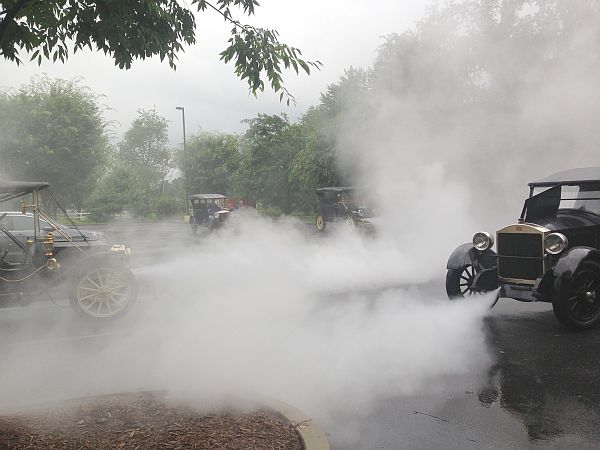
(Photo courtesy Robert Hopkins)
Several of the participants joined the group by modern car at Chestertown and it was decided that the FAHP cars would have their boilers blown down before dinner. Modern cars would be used to ferry tour participants to our dinner reservation while Bob Wilhelm's car, with curtains installed would steam its way to dinner at Uncle Charlie's Bistro.
Pictured (L to R) are the Model 71, Model 725, Model 76, and Model 740 blowing down in the Holiday Inn Express rear parking lot after the 60-mile trip to Chestertown.
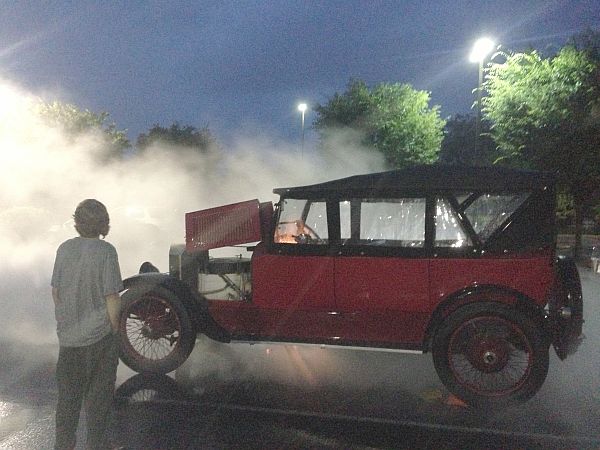
(Photo courtesy Robert Hopkins)
The 735 has six points that allow for the water to be blown out of the boiler. Because the car is a condensing car, steam cylinder oil added to the steam going to the engine for lubrication finds its way into the water tank and boiler. Even though there is a steam cylinder oil separator on the engine exhaust steam line and oil absorbing "socks" in the water tank, some oil still makes it way to the boiler. Opening the blow-down valves allows the water and other impurities to be removed from the boiler so that they do not accumulate and diminish the boiler's ability to make steam.
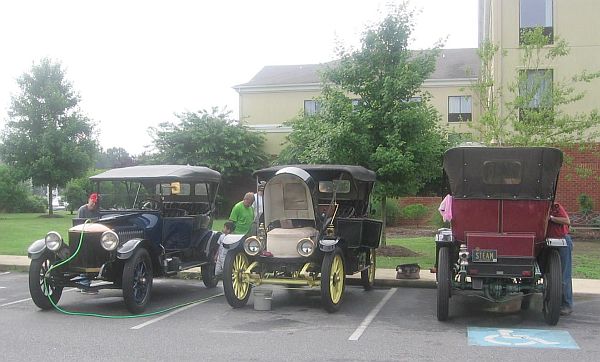
As the drivers prepared their cars for the day's outing, hotel guests coming out to their modern vehicles were fascinated by the collection of steam cars. "What kind of car is that?" "It is a Stanley Steamer." "What, that runs on steam?" "Yup - at 600 pounds pressure." "No $hi+!!, I've read about those and thought they were science fiction."
Pictured left to right is the 1916 Model 725 (having the water tank filled through the condenser cap), 1913 Model 76, and 1912 Model 87. In preparation for our visit the Holiday Inn Express had put out their garden hose and provided us with a key to obtain water to fill each of the Stanley tanks. Kerosene for the cars was available at a service station about a mile from the hotel.
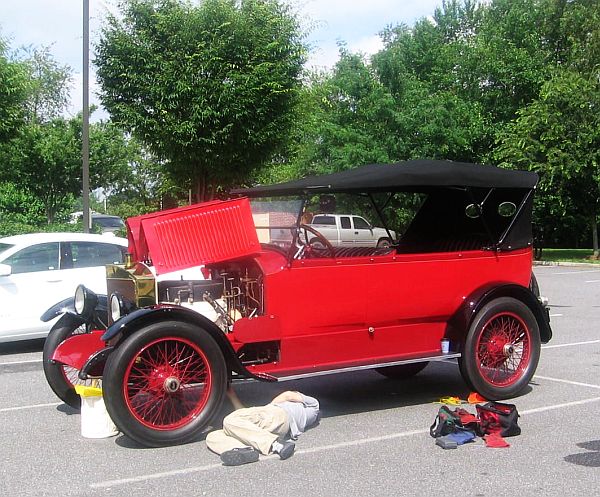
Sam Gregg lies under the car making sure the pilot and burner fuel nozzles are clean. For the last 10-miles or so of the trip on Friday afternoon the burner generated less heat than normal which is a sign of carbon buildup in the vaporizer and nozzle. With the nozzles cleaned, Sam then proceeded to preheat the pilot vaporizer and then light the pilot.
Sitting in front of the car is a collapsible canvas bucket used to drain off several gallons of water from the boiler in order to have space to generate steam. Once the pilot was lit and a gallon or so of water removed from the boiler, the burner could be lit to start making steam for the day's drive.
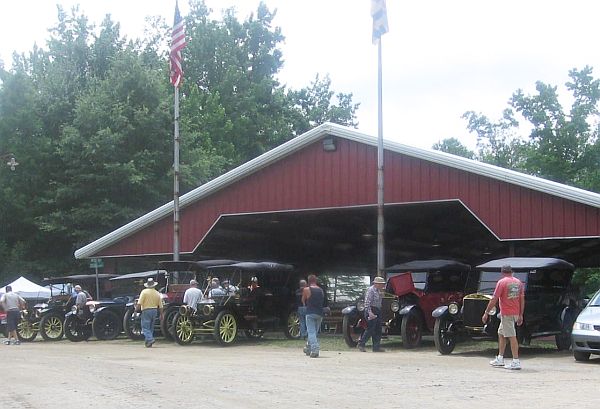
The Model 740 did not make the trip to Tuckahoe due to burner problems. Given the time needed to complete repairs, it was decided that the car would remain at the hotel for the day. Upon returning from Tuckahoe mid-afternoon the repairs were completed and the car was fired up and made the trip to dinner that evening.
On the trip back to the hotel from Tuckahoe we stopped for 15 gallons of kerosene for Bob's Model 725. The 735 was obtaining about 8 miles per gallon of kerosene and 6 miles per gallon of water.
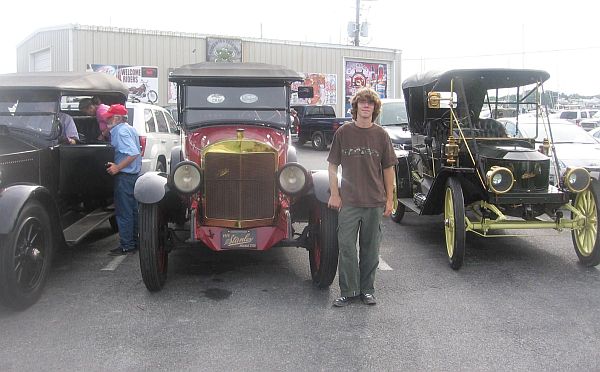
While Bob Wilhelm drove the Stanley to Chestertown in the rain, Sam would take up operating responsibility for the car during the rest of the tour. With the trip to Waterman's Sam had now put more miles on the Stanley for this tour than its owner!
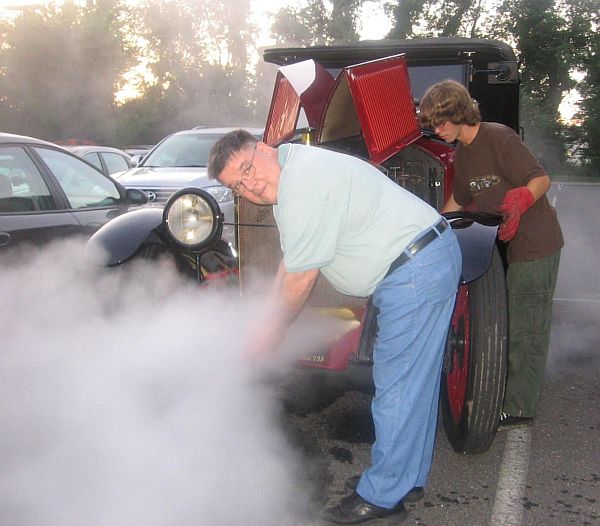
One of the fun things to do when blowing down a boiler is to "wash" one's hands in the steam venting from the car. The water in the boiler is around 500 PSIG and 475° Fahrenheit. However when the water exits the blow-down pipe it immediately changes to atmospheric pressure and cools by the laws of thermodynamics. A mere foot from the end of the blow-down pipe the steam and water spray is a modest 90° Fahrenheit.. Folks are startled by the fact that one can put their hands in the steam and not become burned. Of course the trick is to say at least 6 inches or more from the end of the blow-down pipe or the scalding water exiting at high pressure would cut through one's skin like a hot knife through butter!
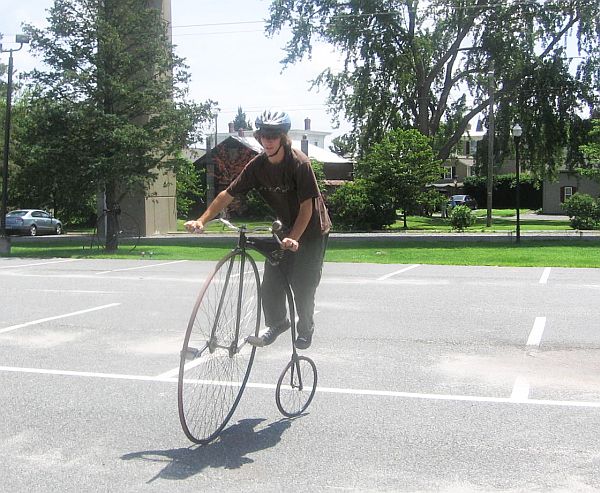
Ed owns a collection of bicycles and had several of his more unique bicycles available for tour members to ride. Pictured, Sam Gregg rides on of Ed's antique bicycles.
With all cars accounted for and those needing water topped off, the group left South Chesapeake City, crossed the Chesapeake City Bridge, and headed to Schaefer's Canal House in North Chesapeake City for an afternoon meal.
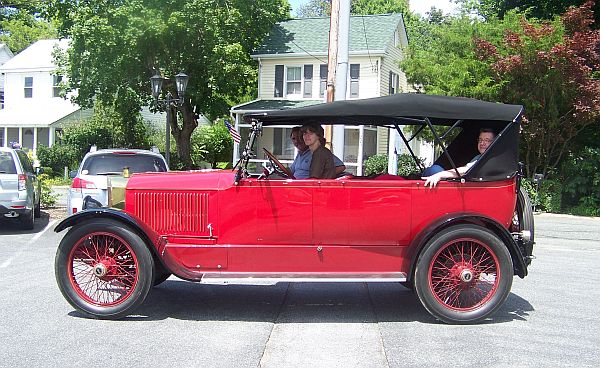
At Schaefer's our group would be joined by FAHP Executive Director Susan Randolph, Ed Lee and his wife, and Richie's wife as well as his mother.
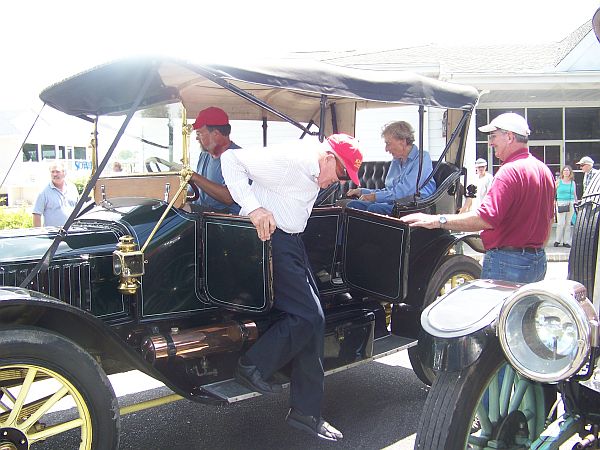
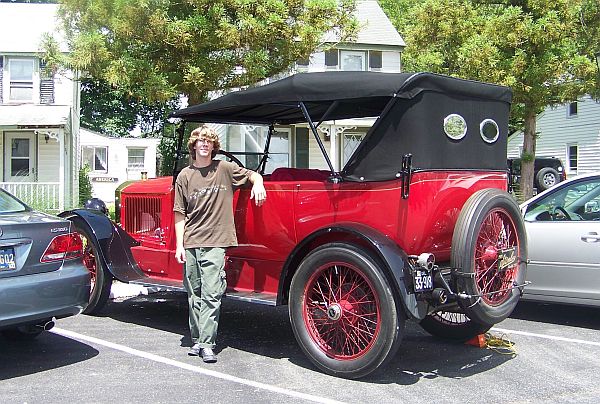
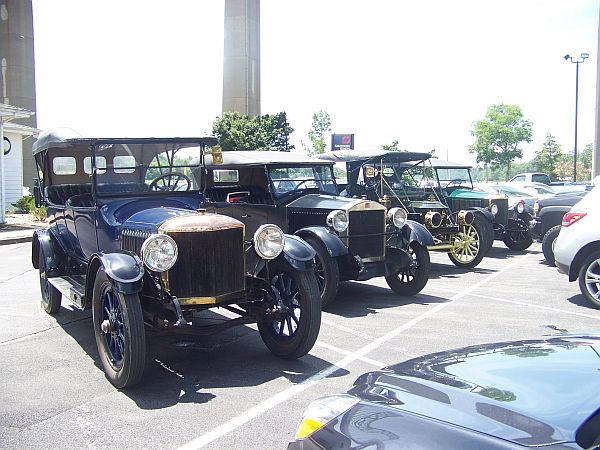
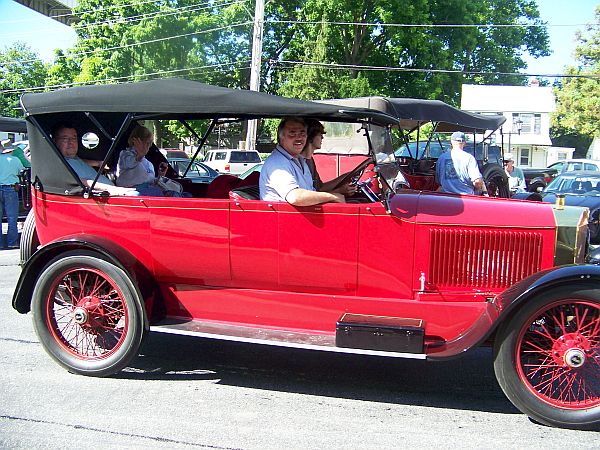
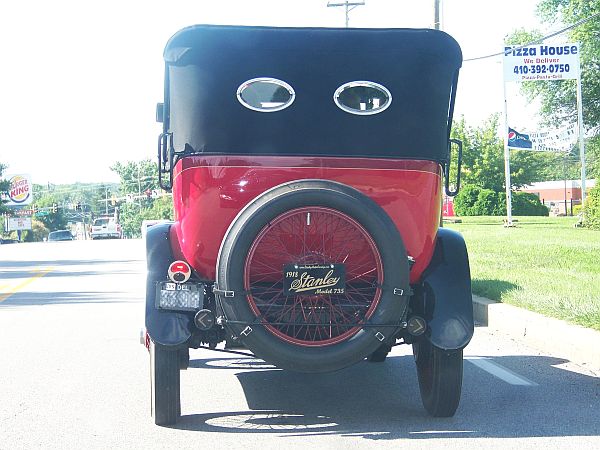
The packing nut backing off and allowing the left cylinder's piston rod packing to blow out was the worst mechanical issue that had to be dealt with (in the rain no less). The burner's heat output was reduced on occasion (until serviced) by carbon flakes partially obstructing the nozzle as a result of the vaporization process (a common problem with Stanley steam car burners). On the final day home we listened to a "Windex Squeaky Clean" sound under maximum throttle which was found to be one of the cylinder caps having its packing blow out.